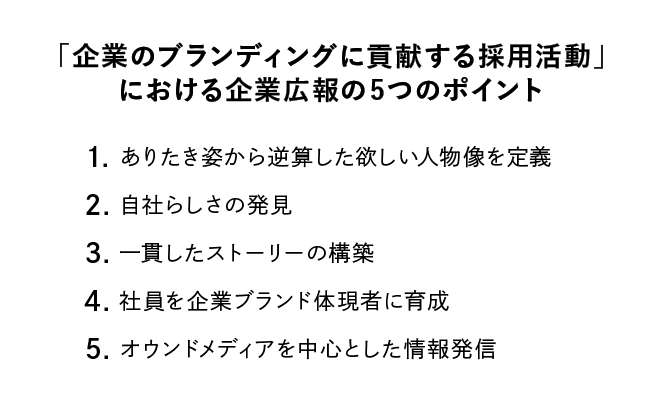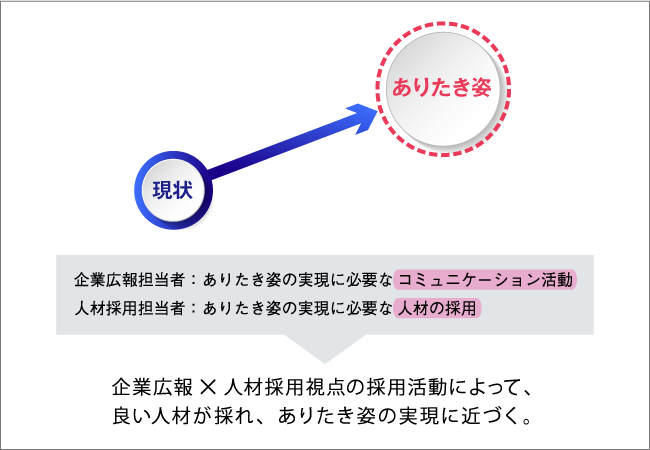The Corporate Communications Strategy Institute, a research organization within Dentsu Inc. PR, views recruitment activities as a crucial opportunity for corporate branding. They developed the "Recruitment Attractiveness Branding Model" as an indicator to measure a company's appeal from the perspective of job-seeking students. In this final installment of the series, we speak with recruitment consultant Masanao Tanide, who co-developed this model, about the latest job-hunting trends and student tendencies. We also introduce key points for corporate branding in recruitment activities.
We present three major trends reflecting significant changes in recruitment activities due to recent population decline and labor shortages.
Trend 1: Earlier Start and Longer Duration of Recruitment Activities
First, the start of recruitment activities is occurring earlier each year. The reason, as discussed in the first installment, is the ongoing student-dominated seller's market that has persisted for about the last five years. Even in a seller's market, the pool of proactive talent sought by many companies is limited. Moreover, the more proactive the job seeker, the more they independently gather information, take initiative, and start their search early. Consequently, companies are also beginning their recruitment activities earlier.
One survey indicates that as of March 2019, 13.9% of students expected to graduate in 2020 had already received job offers.
Furthermore, while the start of recruitment activities is advancing, the timing for the selection process and job offer announcements at major companies and popular firms with many applicants remains unchanged for companies adhering to the Keidanren guidelines. Consequently, recruitment activities tend to extend over a longer period.
Trend 2: Rapid Increase in Companies Utilizing Internships
A major feature is the rapid increase in companies utilizing internships. Recently, regardless of company size, more organizations are incorporating internships into their recruitment flow.
Small and medium-sized enterprises (SMEs) and regional companies actively incorporate internships to raise their profile. Since pre-recruitment awareness directly correlates with the number of applications received during recruitment, unlike large corporations already known to job seekers, these companies must proactively promote themselves to students to be considered as potential employers.
Meanwhile, well-known large corporations incorporate internships to ensure students accurately understand the company's substance. This is because, despite their high profile, students often only know the company name.
Current job seekers then share these internship experiences on social media and review sites. This creates the added benefit of spreading information about the company's image and initiatives.
Trend 3: Diversification of Recruitment Activities
The diversification of recruitment activities is also noteworthy. Companies are now launching unique recruitment initiatives utilizing technology like AI, chatbots, and videos.
These trends emerged as strategies for companies to secure top talent. Given the ongoing trends of declining birthrates and labor shortages, the movement toward earlier and more diverse recruitment activities is likely to continue, barring a significant economic downturn.
Recruiters, already juggling other HR duties, are extremely busy due to the prolonged and diversified recruitment cycles resulting from earlier start dates. Many have transitioned into recruitment roles through job rotation and may not be recruitment specialists. Consequently, current practices often remain formulaic: replicating past recruitment methods, relying on their own job-hunting experiences, or simply following competitors' moves.
To break this cycle, companies must shift from "recruitment that gathers people" to "building a company that attracts people." What does "building a company that attracts people" mean in concrete terms? Using a Tokyo public bathhouse as an example, we'll explain an effective recruitment approach for the future in three steps.
STEP 1: Redefine the Concept
While the public bath industry struggles with declining customers, this particular bathhouse thrives. The catalyst was redefining what a "public bath" is. They shifted from being merely a "place for public hygiene" to establishing a new definition: "a place to recognize connections with the community."
STEP 2: Implement Concrete Initiatives Based on the Definition
Next, based on the definition of "a place that fosters community connections," they implemented initiatives like hosting live performances by local musicians and organizing sake bath events where they invited sake brewery representatives to lead tasting sessions. These activities, true to the definition, connect people within the community.
STEP3: Actively share information
We then shared these initiatives on social media. Gradually, more people began visiting, and the bathhouse became bustling.
When the bathhouse advertised for employees, positions filled up in no time. Consistency between our definition and actions built a fanbase, naturally attracting people who thought, "I want to work at this bathhouse."
Corporate recruitment works the same way.
STEP1 Propose an appealing story (definition)
STEP2: Take concrete actions based on that story
STEP3: Communicate the story and initiatives
By consistently performing these activities, regardless of the hiring period, you can increase your company's fan base and attract more applicants.
The crucial point here is STEP 2: it's not enough to just propose a story; you must actually implement concrete initiatives based on it. As discussed in the second session, job seekers gather information through review sites, so they'll quickly see through a story that's just window dressing.
Furthermore, corporate communications plays a vital role in STEP 3. To ensure your stories and initiatives are known, you must consistently share them on your company website and social media, while also reaching students through media channels. Conducting PR activities alongside recruitment efforts also has the advantage of effectively reaching the "proactive job seekers actively gathering information" that companies seek.
By naturally attracting people who resonate with the company in this way, we can also expect fewer hiring mismatches and fewer new hires leaving within months.
Moving forward, recruitment efforts must involve collaboration across the entire company—not just HR, but also PR and other departments involved in initiatives—to consistently communicate a unified story.
In the increasingly prolonged and diverse recruitment landscape, building a fanbase is essential—a principle that applies to overall corporate branding as well. As mentioned in Part 1, job seekers can become important stakeholders even if they don't join the company. Turning them into fans can lead to branding that yields benefits over the medium to long term.
Therefore, beyond just "recruitment activities to hire good talent," we present five essential corporate PR points from the perspective of "recruitment activities that contribute to corporate branding."
① Define the desired candidate profile by working backward from your ideal company vision
While the mission differs by department—such as recruitment or PR—the ultimate goal is shared: "realizing the desired future state."
Simply extending current practices to define desired hires will not achieve the ideal state. Work backward from the ultimate corporate goal—realizing the ideal state—by interviewing executives, HR leaders, and key internal stakeholders to concretely define the talent required.
② Discovering Your Company's Unique Identity
Utilize the four categories of "Recruitment-focused Company Appeal," one component of the "Recruitment Appeal Branding Model" introduced in Part 1. Collect and analyze both internal and, at times, external public and non-public information. Crucially, focus on inventorying concrete facts, not just perceptions.
③ Building a Consistent Story
Develop a story based on the discovered company identity and facts. The "Recruitment Activities" and "Social Trends" components of the "Attractiveness Branding Model for Recruitment" should be selected not only from the perspective of desired candidates but also from the perspective of company identity and facts, creating a consistent narrative. Similarly, the specific initiatives developed based on this story must incorporate both perspectives.
④ Cultivating Employees as Brand Ambassadors
As mentioned in Part 2, job seekers' various information sources ultimately lead them to employees. While this is a medium-to-long-term effort, internal branding🄬※1 is also essential for employees—who have diverse touchpoints with job seekers—to become brand ambassadors.
※1 Activities where employees deepen their understanding of the company's philosophy and vision, act as brand ambassadors by aligning their behavior with these values, and build a strong corporate brand from within. (Registered trademark of Dentsu Inc. Public Relations)
⑤ Information Dissemination Centered on Owned Media
Information dissemination for corporate branding through recruitment activities is based on owned media. First, we establish a foundation for information dissemination by placing rich content on owned media: ① the specific desired candidate profiles defined in step ①, ② the attractive facts about the company identified in step ②, ③ the concrete initiatives created in step ③, and ④ the compelling employees cultivated in step ④. Based on this content, we then develop recruitment events, create recruitment brochures, produce advertisements, and attract media coverage.
Recruitment activities are extremely demanding, but by mobilizing the entire company and collaborating while keeping the above five points in mind, they will contribute to both recruitment success and corporate branding. Over three installments, we have explained the key points of corporate branding through recruitment activities. To implement better recruitment practices, why not use this as an opportunity to review your company's recruitment activities?











